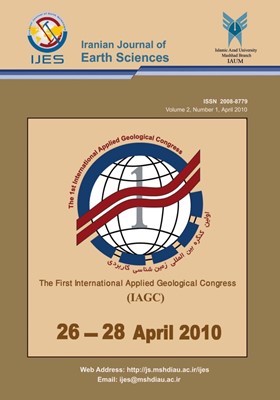Sustainable Ground Water Development in Hard Rock Aquifers in Low-Income Countries and the Role of UNESCO _ IUGS - IGCP projec -GROWNET-
Subject Areas : Mineralogy
1 - Project Leader, UNESCO-IUGS-IGCP Project GROWNET
Ground Water Institute, Pune, India
Keywords:
Abstract :
Hard rock aquifers for the purpose of this Paper mean the non-carbonate, fractured rock aquifers in the terrain covered by crystalline basement complex, metamorphic rocks and also by extensive effusive volcanic rocks like the basalts of western India (Deccan traps. Ground water development in hard rock aquifer areas has always played a secondary role compared to that in the areas having high-yielding unconsolidated or semi-consolidated sediments and carbonate rocks. This has been due to the relatively poor ground water resources in hard rocks, low specific capacity of wells, erratic variations and discontinuities in the aquifer properties, and difficulties in exploration and assessment of the resource. It should, however, be remembered that for the millions of farmers in developing countries, having their small farms in the barren landscape of fractured hard rock terrain, whatever small supply available from these poor aquifers is the only hope for upgrading their standard of living by growing irrigated crops or by protecting their rain-fed crops from the vagaries of rainfall. It is also their only source for drinking water for the family and cattle. In many developing countries, hard rock hydrogeologists have therefore, an important role to play. In the developed countries, the interest in hard rock hydrogeology, apart from drinking water supplies to small communities, is recently promoted by the prospects of using these low permeability rocks for the storage of hazardous nuclear and chemical wastes. The study of ground water flow through faults, fissures and fractures is also of interest to scientists studying the migration of contaminants. Hard rock hydrogeologists, the world over, are therefore divided into two main groups: Those interested in obtaining ground water for domestic, irrigational or industrial use by exploring fractured and permeable zones in a relatively less permeable matrix of hard rock and those interested in locating impermeable or the least permeable zones for storage of hazardous nuclear waste. Ironically, for the first group even the most permeable zones are often not good enough to yield adequate water supply, while for the second group even the least permeable zones are often not good enough for safe storage of hazardous nuclear waste over a prolonged period of a few hundred years. This Paper discusses the occurrence of ground water and the precautions for sustainable development of ground water in arid and semi-arid regions, in view of the forthcoming climatic changes. It emphasizes the need for recharge augmentation hand-in-hand with development of new wells, so that the new development does not harm the traditional practices. In India, the neglect of recharge augmentation has caused lowering of water table and drying-up of old dug-wells of 12m to 15 m depth, which used to provide irrigational and drinking water supply for last several centuries. In Iran, many Qanats have dried up because of lowering of water table due to heavy pumping of ground water from newly developed deep tube-wells in their vicinity. The goal in many countries has, therefore, shifted from ground water development to ground water management which includes management of the quantity on Supply side and Demand side and also the management of ground water quality, especially with respect to pollution and salt water intrusion. Pollution of ground water in urban environment is becoming a cause of worry because in many developing countries there is a heavy migration of population from rural areas to urban centers and providing safe quality of drinking water to this population and managing the waste water generated in the cities and towns, is a major problem. The role of UNESCO-IUGS-IGCP Project GROWNET (Ground Water Network for Best Practices in Ground Water Development in Low Income Countries) is also described towards the end of this Paper. The Author is the Project Leader for GROWNET.


